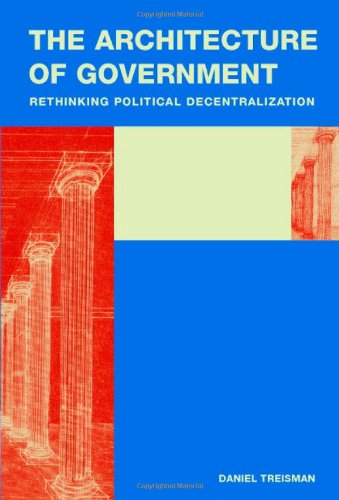

Most ebook files are in PDF format, so you can easily read them using various software such as Foxit Reader or directly on the Google Chrome browser.
Some ebook files are released by publishers in other formats such as .awz, .mobi, .epub, .fb2, etc. You may need to install specific software to read these formats on mobile/PC, such as Calibre.
Please read the tutorial at this link. https://ebooknice.com/page/post?id=faq
We offer FREE conversion to the popular formats you request; however, this may take some time. Therefore, right after payment, please email us, and we will try to provide the service as quickly as possible.
For some exceptional file formats or broken links (if any), please refrain from opening any disputes. Instead, email us first, and we will try to assist within a maximum of 6 hours.
EbookNice Team

Status:
Available4.3
16 reviews
ISBN-10 : 0521872294
ISBN-13 : 9780521872294
Author: Daniel Treisman
Since the days of Montesquieu and Jefferson, political decentralization has been seen as a force for better government and economic performance. It is thought to bring government 'closer to the people', nurture civic virtue, protect liberty, exploit local information, stimulate policy innovation, and alleviate ethnic tensions. Inspired by such arguments, and generously funded by the major development agencies, countries across the globe have been racing to devolve power to local governments. This book re-examines the arguments that underlie the modern faith in decentralization. Using logical analysis and formal modeling, and appealing to numerous examples, it shows that most are based on vague intuitions or partial views that do not withstand scrutiny. A review of empirical studies of decentralization finds these as inconclusive and mutually contradictory as the theories they set out to test.
1 Introduction
1.1 A Quick Look Back
1.2 The Arguments
1.2.1 Decentralization – Good or Neutral
1.2.2 Decentralization – Bad
1.3 A Note on Methods: Formal Modeling
1.4 Overview
2 The Political Process
2.1 Defining Decentralization
2.2 Modeling Politics
2.2.1 Three Games
2.2.2 Preferences of Actors
2.2.3 The Leadership Selection Game
2.2.4 The Policy Game
2.2.5 The Economic Game
2.2.6 Introducing Multiple Tiers
3 Administrative Efficiency
3.1 Optimal Scale
3.2 Heterogeneous Tastes and Policy Differentiation
3.3 Costs of Organization
3.3.1 Costs of Operating Government Offices
3.3.2 Communication Costs
3.3.3 Agency Costs and Loss of Control
3.4 Conclusion
4 Competition among Governments
4.1 Competing for Mobile Residents
4.1.1 Tiebout’s Argument
4.1.2 Restrictive Assumptions and Problems of Equilibrium
4.1.3 Mobility under Centralization
4.2 Competing for Mobile Capital
4.2.1 Constraining Leviathan
4.2.2 Heterogeneous Regions and Uneven Competition
4.2.3 Introducing a Central Government
4.2.4 Competing by Building Infrastructure
4.2.5 If Competition Does Occur, Is It Beneficial?
4.2.6 Conclusion
5 Fiscal Policy and Redistribution
5.1 The “Common Pool”
5.2 The “Soft Budget Constraint”
5.2.1 A Simple Model of Soft Budget Constraints on Local Governments
5.2.2 Local Governments Commit to a Tax Rate, Not a Spending Level
5.2.3 Central Government Cares More About Public Spending, or Less About Private Consumption, Than L
5.2.4 Central Government Cares More About Some Localities
5.2.5 Local Governments Constrain the Center’s Supply of Funds
5.2.6 Transfers in a Repeated Game
5.2.7 Conditional Arguments and Proposed Remedies
5.2.8 Conclusion
5.3 Decentralizing Redistribution
6 Fiscal Coordination and Incentives
6.1 Vertical “Overgrazing”
6.2 Fiscal Decentralization and Incentives
6.2.1 The Standard Argument
6.2.2 Adding a Central Government
6.2.3 Summing Up
7 Citizens and Government
7.1 Civic Virtue
7.2 Accountability
7.2.1 Informational Advantages
7.2.2 Coordination
7.2.3 Accountability as Respecting Majority Preferences
7.2.4 Career Incentives for Officials
7.2.5 Summing Up
A.1 No Distributive Politics; Certainty
A.2 Distributive Politics; Certainty
A.3 Uncertainty
8 Checks, Balances, and Freedom
8.1 Freedom
8.1.1 Strong Subnational Governments Protect Against Central Abuses
8.1.2 Interjurisdictional Mobility and Freedom
8.2 Policy Stability
9 Acquiring and Using Knowledge
9.1 Information
9.1.1 Information Gathering as a Technical Problem
9.1.2 Information Gathering as a Strategic Problem
9.1.3 The Motivation of Governments
9.2 Policy Experimentation
10 Ethnic Conflict and Secession
10.1 Satisfying Limited Demands for Autonomy
10.2 Splitting the Prizes of Politics
10.3 Restraining the Central Government
10.4 Socializing Politicians
10.5 Stimulating Growth of Small Ethnic Parties
10.6 Conclusion
11 Data to the Rescue?
11.1 The Quality of Government
11.2 Economic Performance
11.3 Ethnic Conflict
11.4 Democracy
11.5 Stable Policies
11.6 Conclusion
12 Conclusion: Rethinking Decentralization
12.1 Possible Objections
12.1.1 No Models Are Completely General; No Institutions Always “Work ”
12.1.2 Models Are Tools; When They Fail, One Should Adapt Them
12.1.3 Models Are Metaphors; One Should Not Take Them Literally
12.1.4 Of Course Decentralization Is Not Always Good; It Must Be “Well Designed” and Introduced
12.2 Explaining Decentralization’s Appeal
12.3 A New Agenda?
an icon is a work of architecture for the government
government architecture definition
government architecture
the architecture of the city
government architecture examples
Tags: The Architecture, Government, Rethinking Political, Decentralization, Daniel Treisman